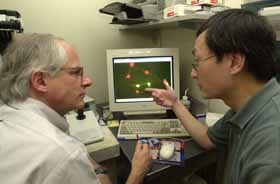|
This is an archived article. For
the latest news, go to the Advance
Homepage
For more archives, go to the Advance Archive/Search Page. |
||
|
Neuroscientists Studying Chemicals
That 'Talk' to Other Cells Dick Mains and Betty Eipper have their work cut out for them. They know it, yet they are unfazed. Their goal is to understand bioactive peptides in order to facilitate the design of therapeutic strategies to halt the onset and progress of diseases of the nervous system and even to repair a damaged nervous system. Richard "Dick" Mains, is holder of the William Beecher Scoville M.D. chair in neurosciences and chairman and head of the Health Center's Department of Neuroscience. Elizabeth "Betty" Eipper, a long-time collaborator with Dr. Mains, is a professor in the departments of neuroscience and physiology. The dawn of the 21st century is a good time to be a neuroscientist, says Mains, because research and equipment are sufficiently advanced to promote rapid results. "The tools available now, particularly molecular biology techniques and transgenic mice, make the work considerably easier," he says. "You can take a basic understanding and test it in an in vivo system and quickly learn if your ideas are right." The Department of Neuroscience, established relatively recently, is an outgrowth of the Health Center's initial strategic plan. It is part of the Brain and Human Behavior signature program. The department maintains laboratories in the new Academic Research Building as well as the main academic building, and brings together such disparate disciplines as biochemistry, anatomy, physiology, microbiology, pharmacology, surgery, psychiatry, endocrinology, neurology. All are used in looking at the growth, development, normal function and degeneration of the nervous system.
Dr. Eipper is investigating peptides, too, but her inquiry has led to questions about how cells provide the secretory granules with the environment they need to do their jobs. Current initiatives involve understanding the way in which cells provide toxic trace metals such as copper and essential factors like vitamin C to the secretory granule proteins that need them in order to function properly. Mains and Eipper explain one practical value their research might yield. Electroconvulsive therapy is a procedure that causes a seizure in the brain by passing a mild electric current through the brain. ECT is one of the most effective treatments that exists for depression, and it is also used to treat mania or schizophrenia. It is thought to work by shocking the cells and chemically "resetting" them. Yet it can have serious side effects, one of which - though rare - is permanent memory loss. But suppose the mechanisms underlying successful electroconvulsive therapy - the chemical resetting - were understood by neuroscience? Armed with this understanding, a drug could be fashioned to induce the same outcome but without using the potentially trauma-laden procedure of electrical overstimulation. Similarly, neuroscientists today suspect kalirin, a protein discovered in the Eipper-Mains lab because of its interaction with peptide-containing secretory granules, works inside the cell and causes neurons to extend new processes and change the way they talk to their targets. Suppose that knowledge of kalirin and its chemical abilities were sufficiently advanced that DNA encoding kalirin could be applied to the outside of a neuron to coax it to grow to repair a spinal chord injury or other devastating injuries to the nervous system? "It's not what we do, since our work is more basic," Eipper says, "but these are conceivable practical outcomes." In the meantime, there's more work to do. "It's new and different every day and every week," she says. "It's exciting, and it's great to see the students and post-docs maintain that excitement as they proceed with their scientific careers." Patrick Keefe |

